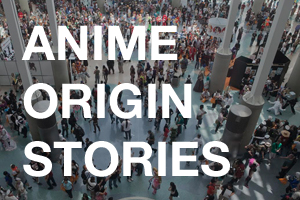One of America’s most well known cosplay photographers is Ejen Chuang. His photography book, Cosplay in America, is half photojournalism, half work of art.
I first heard about Ejen when I saw his book for sale at an anime convention. When I found out he reads my blog, I knew I had to interview him! It took guts for Ejen to decide to publish a book on its own, as well as to choose to portray a human side of cosplay that rarely makes its way into the mainstream media. This all qualifies him as an otaku photojournalist in my book.
This month, Ejen is promoting a Kickstarter to fund a sequel to Cosplay in America. I asked him about that – and all things cosplay – in our email interview:
OJ: How did you first become a convention photographer?
EC: I first became a convention photographer in 2008 when Anime Expo moved to the Los Angeles Convention Center. At that time, I had gotten off work (I work freelance as a photographer’s assistant) and was driving east out of downtown. I passed one of the convention center signs advertising Anime Expo coming up next weekend. I was aware of AX as the largest anime convention. In the late ‘90s, I had attended A-Kon in Dallas, Texas—I wasn’t as hardcore of a con goer as I am today so I didn’t return back to A-Kon, and when I moved to Los Angeles to pursue photography, I put it in the back of my mind until 2008.
I knew about cosplay before I even went to AX. I had seen it online, but never in person. I decided to bring my gray backdrop and light I rented from a camera shop. At first I only plan to shoot for a hour or so but I had so much fun, I kept shooting, and returned the next day to keep photographing. At first I approached it as a photographer, but as I got to know the people and hear their stories, I became more interested.
How did you come up with the idea for the first Cosplay in America book?
I formulated the book idea between 2008 and 2009. My friend Bill ran an independent art/photography/design bookstore in downtown LA and I used to walk by and chat with him. I showed him the photos I took and he urged me to do a book. It took me a long time to accept the concept—simply because to create a book seems so daunting but Bill was willing to give me a hand as well as help finance the project. He suggested some titles, but I always liked Cosplay in America. It was simple. The title told you exactly what you would expect to see. Cosplay in America!
One of the things that I love about Cosplay in America is the way it captures a spectrum of cosplays, not just the most attractive or the strangest looking. Why did you decide to photograph such a range of cosplayers?
I felt unqualified to be anything of a judge. Who am I to pass judgement? Growing up in Houston, Texas, I was picked on in high school. I used to escape my world by reading comic book and watching anime. Back then, it wasn’t cool to do those things. Comic books were one thing, but anime labeled you as a geek. It was almost a decade before I returned to conventions and in those years, the fandom had changed. There was a wider fan base, and a lot more people—different people, different backgrounds—were into it. I saw America in the crowds at Anime Expo: a mixture of everybody—black, white, Hispanic, Asian. My idea was to make a book that would show the wide scope of people I met at a convention without regard to “who was the best” or “who was the most attractive.” I just wanted to celebrate people who cosplayed. That was it.
How was the first book received? How many copies did you sell?
The first book was received far better than my expectations. I was really surprised at how people responded to the fact that it was just normal folks cosplaying. People saw themselves in the faces of the book and could definitely relate. It was neither the best nor the worst, just random cosplayers. I think this was the first time, as one cosplayer told me, that regular people could be seen cosplaying in a book.
This intrigued me and I researched a few Japanese cosplay books. To me, it was more just photos of pretty people in costumes. I like the American do-it-yourself mentality to costuming. Though a big chunk of the costumes in the book are handmade, there are people who bought their cosplay or commissioned cosplays in the first book. I personally had no problem with that. The book was to show the range of people you would met if you went to a convention, not to select and highlight specific ones.
I printed only a few thousand copies—I couldn’t afford much as I basically maxed out three credit cards and took out a bank loan to pull off this feat. I managed to make my money back but it took four years of constantly selling at conventions.
One thing I’ve learned is that those of us in fandom can have a hard time asking for money. For example, Scamp has been running The Cart Driver for five years and yet he still won’t take donations! (Personally, I wish he would; there are lots of fans doing cool stuff whom I’d like to donate to.) How did you get over this mindset in order to launch your Kickstarter?
Kickstarter did not exist when I started on the first book and if it was around, I would have used it. Look, the main part of my Kickstarter campaign is the $45 reward level which gets you your own book. My first book was $40. Shipping was $5. Total: $45. I expect the second book to cost the same amount. I’m basically using the Kickstarter platform to pre-sell the book. People already know what Cosplay in America is, I’m just pre-selling the book ahead of time by a year and a half. I’m fully committed to producing and distributing this book if the Kickstarter succeeds.
Additionally, why self publish? Why not look for a book deal since your first book did so well?
Honestly, the book publishing world has not been the same in the decade since the emergence of digital media. Perhaps back in the day, a publisher would have advanced royalties on a well-received author but in today’s world it is much different. One of the photography publishers I know on the East Coast pays their photographer by books. The industry is much tougher these days and to make money means squeezing more than ever. To expect an advance would probably be a pipe dream.
By the way, although the book was very well received, financially it did not make a lot of money. Most of the money went back to traveling to cons and expenses. I still have day job as a photographer and photographer’s assistant to keep my bills paid. And I would suggest to people if they expect to make money by producing books, there are a whole lot of better ways to do so than selling books.
Finally, I did this pretty much on my own the first time, and now that I have more experience, I’d rather just keep doing it the same way I’ve done before. Believe me, this will not be a bestseller. You will not find this on the New York Times list. This is very much a personal project.
How will your second book be different from the first? Any new features we can look forward to?
Since I started taking photos of cosplayers in 2008, a lot has changed in cosplay. The way we communicate and view the media has changed in drastic ways that we could not have foreseen in 2008. One thing I noticed is how media—both fandom and mainstream—focus on what I call the final product, the costume that is already finished and on display. We see tons of photos on Flickr and Facebook from the conventions but unless we are following a particular cosplayer, we don’t see the work-in-progress. Unless we are at a convention, we don’t see how cosplayers interact with a range of people at conventions.
I’m always curious about the story behind the creation so I decided the second book will be two parts. First, portraits done exactly like the first book with a range of cosplayers wearing everything from homemade to commissioned to store bought costumes. Second, behind the scenes looks at cosplay. From the creation of cosplay or prop, to getting ready at the con, to the con floor. I like to call it a day in a life of a cosplayer—but instead of one cosplayer, it is many cosplayers.
I don’t think any book has even attempted to tell the complete story of cosplay but I’m willing to devote the next few years of my life to bring this story to a book. I’ve always had an interested in photojournalism although I never pursued it as a career. I figured this is a good way to experiment with that in a book format.
I haven’t totally nailed down the final look of the book, but there will be interviews and essays, too.
Do you have any advice for fans with big ideas who want to follow in your footsteps?
The one thing I learn is to find your own path. Everyone has their own path. Just because person does it X + Y + Z does not mean the result will be the same for you. For example, when I started photography, I copy other photographer whose work I admired. I basically turned out to be a copycat. It took years for me to find my own voice. I realized that the photography industry looks for a unique voice, so i stopped buying fashion magazines, I stopped copying photographers. I just try to do what makes me happy and hope people enjoy what I do.
Photo by Nerd Society. Check out their interview with Ejen, too!





2 Comments.
[…] Ejen Chuang of Cosplay in America checked out the cosplay scene in Denmark and made a 30 minute documentary about what he saw. […]
[…] you have a really geeky tattoo? Ejen Chuang, the author of Cosplay in America, wants to photograph […]